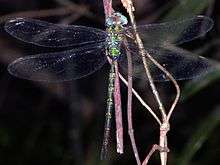Gynacantha
| Gynacantha | |
|---|---|
 | |
| G. subinterrupta | |
| Scientific classification | |
| Kingdom: | Animalia |
| Phylum: | Arthropoda |
| Class: | Insecta |
| Order: | Odonata |
| Family: | Aeshnidae |
| Genus: | Gynacantha Rambur, 1842 |
Gynacantha is a genus of dragonflies in the family Aeshnidae. The females have two prominent spines under the last abdominal segment.[1] This gives the genus name (from Greek female and thorn) and the common name two-spined darners. They are also commonly known as duskhawkers.
The genus contains the following species:[2]
- Gynacantha adela Martin, 1909
- Gynacantha africana (Palisot de Beauvois, 1805) - Giant Duskhawker
- Gynacantha albistyla Fraser, 1927
- Gynacantha alcathoe Lieftinck, 1961
- Gynacantha apiaensis Fraser, 1927
- Gynacantha apicalis Fraser, 1924
- Gynacantha arnaudi Asahina, 1984
- Gynacantha arsinoe Lieftinck, 1948
- Gynacantha arthuri Lieftinck, 1953
- Gynacantha auricularis Martin, 1909
- Gynacantha bainbriggei Fraser, 1922
- Gynacantha bartai Paulson & von Ellenrieder, 2005
- Gynacantha basiguttata Selys, 1882
- Gynacantha bayadera Selys, 1891 (= G. furcata?)
- Gynacantha bifida Rambur, 1842
- Gynacantha biharica Fraser, 1927
- Gynacantha bispina Rambur, 1842
- Gynacantha bullata Karsch, 1891 - Black-kneed Duskhawker
- Gynacantha burmana Lieftinck, 1960
- Gynacantha calliope Lieftinck, 1953
- Gynacantha calypso Ris, 1915
- Gynacantha caudata Karsch, 1891
- Gynacantha chelifera McLachlan, 1895
- Gynacantha comorensis Couteyen & Papazian, 2009
- Gynacantha constricta Hämäläinen, 1991
- Gynacantha convergens Förster, 1908
- Gynacantha corbeti Lempert, 1999
- Gynacantha croceipennis Martin, 1897
- Gynacantha cylindrata Karsch, 1891 - Greater girdled Duskhawker
- Gynacantha demeter Ris, 1911
- Gynacantha dobsoni Fraser, 1951 – lesser duskhawker[3]
- Gynacantha dohrni Krüger, 1899
- Gynacantha dravida Lieftinck, 1960
- Gynacantha ereagris Gundlach, 1888
- Gynacantha francesca (Martin, 1909)
- Gynacantha furcata Rambur, 1842
- Gynacantha gracilis (Burmeister, 1839)
- Gynacantha helenga Williamson & Williamson, 1930
- Gynacantha hova Fraser, 1956
- Gynacantha hyalina Selys, 1882
- Gynacantha immaculifrons Fraser, 1956 - Pale Duskhawker
- Gynacantha incisura Fraser, 1935
- Gynacantha interioris Williamson, 1923
- Gynacantha japonica Bartenev, 1909
- Gynacantha jessei Williamson, 1923
- Gynacantha khasiaca McLachlan, 1896
- Gynacantha kirbyi Krüger, 1898 – slender duskhawker[3]
- Gynacantha klagesi Williamson, 1923
- Gynacantha laticeps Williamson, 1923
- Gynacantha limbalis Karsch, 1892
- Gynacantha litoralis Williamson, 1923
- Gynacantha maclachlani Förster, 1899
- Gynacantha malgassica Fraser, 1962
- Gynacantha manderica Grünberg, 1902 – little duskhawker[4]
- Gynacantha membranalis Karsch, 1891
- Gynacantha mexicana Selys, 1868 – bar-sided darner[1][5]
- Gynacantha mocsaryi Förster, 1898 – paddle-tipped duskhawker[3]
- Gynacantha musa Karsch, 1892
- Gynacantha nausicaa Ris, 1915
- Gynacantha nervosa Rambur, 1842 – twilight darner[6]
- Gynacantha nigeriensis (Gambles, 1956) – yellow-legged duskhawker[5][7]
- Gynacantha nourlangie Theischinger & Watson, 1991 – cave duskhawker[3]
- Gynacantha odoneli Fraser, 1922
- Gynacantha pasiphae Lieftinck, 1948
- Gynacantha penelope Ris, 1915
- Gynacantha phaeomeria Lieftinck, 1960
- Gynacantha radama Fraser, 1956
- Gynacantha rammohani Mitra & Lahiri, 1975
- Gynacantha remartinia Navás, 1934
- Gynacantha risi Laidlaw, 1931
- Gynacantha rolandmuelleri Hämäläinen, 1991
- Gynacantha rosenbergi Kaup in Brauer, 1867 – grey duskhawker[3]
- Gynacantha rotundata Navás, 1930
- Gynacantha ryukyuensis Asahina, 1962
- Gynacantha saltatrix Martin, 1909
- Gynacantha sextans McLachlan, 1896 - Dark-rayed Duskhawker
- Gynacantha stenoptera Lieftinck, 1934
- Gynacantha stevensoni Fraser, 1927
- Gynacantha stylata Martin, 1896
- Gynacantha subinterrupta Rambur, 1842
- Gynacantha tenuis Martin, 1909
- Gynacantha tibiata Karsch, 1891
- Gynacantha usambarica Sjöstedt, 1909 – Usambara duskhawker[8]
- Gynacantha vesiculata Karsch, 1891
- Gynacantha villosa Grünberg, 1902 – hairy duskhawker[9]
References
- 1 2 Paulson, Dennis R. (2009). Dragonflies and Damselflies of the West. Princeton University Press. ISBN 0-691-12281-4.
- ↑ Martin Schorr; Martin Lindeboom; Dennis Paulson. "World Odonata List". University of Puget Sound. Retrieved 3 Oct 2013.
- 1 2 3 4 5 Günther Theischinger; John Hawking (2006). The Complete Field Guide to Dragonflies of Australia. CSIRO Publishing. ISBN 0-643-09073-8.
- ↑ Clausnitzer, V., Suhling, F. & Dijkstra, K.-D.B. (2009). "Gynacantha manderica". IUCN Red List of Threatened Species. Version 2010.3. International Union for Conservation of Nature. Retrieved 13 December 2010.
- 1 2 "North American Odonata". University of Puget Sound. 2009. Retrieved 5 August 2010.
- ↑ Paulson, D. R. (2007). "Gynacantha nervosa". IUCN Red List of Threatened Species. Version 2010.3. International Union for Conservation of Nature. Retrieved 13 December 2010.
- ↑ Clausnitzer, V., Suhling, F. & Dijkstra, K.-D.B. (2009). "Gynacantha nigeriensis". IUCN Red List of Threatened Species. Version 2010.3. International Union for Conservation of Nature. Retrieved 13 December 2010.
- ↑ Clausnitzer, V. & Suhling, F. (2009). "Gynacantha usambarica". IUCN Red List of Threatened Species. Version 2010.3. International Union for Conservation of Nature. Retrieved 13 December 2010.
- ↑ Clausnitzer, V., Suhling, F. & Dijkstra, K.-D.B. (2009). "Gynacantha villosa". IUCN Red List of Threatened Species. Version 2010.3. International Union for Conservation of Nature. Retrieved 13 December 2010.
| Wikimedia Commons has media related to Gynacantha. |
This article is issued from Wikipedia - version of the 7/21/2016. The text is available under the Creative Commons Attribution/Share Alike but additional terms may apply for the media files.